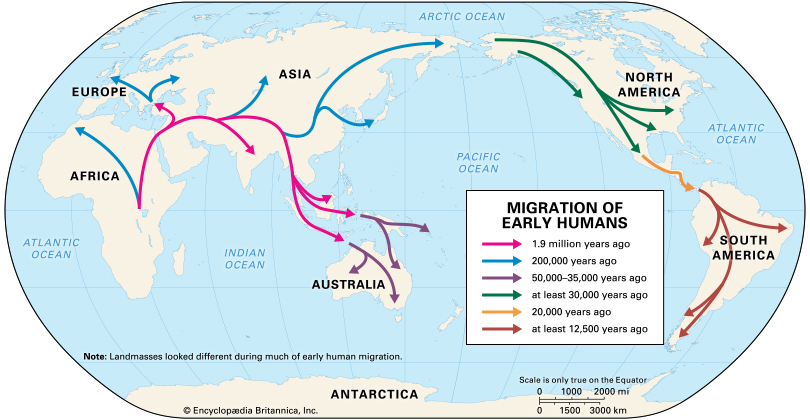Pangea and Continental Drift
Pangea was surrounded by a global ocean called Panthalassa, and it was fully assembled by the Early Permian Epoch (some 299 million to 273 million years ago). The supercontinent began to break apart about 200 million years ago, during the Early Jurassic Epoch (201 million to 174 million years ago), eventually forming the modern continents and the Atlantic and Indian oceans. Pangea’s existence was first proposed in 1912 by German meteorologist Alfred Wegener as a part of his theory of continental drift. Its name is derived from the Greek pangaia, meaning “all the Earth.”
During the Early Permian, the northwestern coastline of the ancient continent Gondwana (a paleocontinent that would eventually fragment to become South America, India, Africa, Australia, and Antarctica) collided with and joined the southern part of Euramerica (a paleocontinent made up of North America and southern Europe). With the fusion of the Angaran craton (the stable interior portion of a continent) of Siberia to that combined landmass during the middle of the Early Permian, the assembly of Pangea was complete. Cathaysia, a landmass comprising the former tectonic plates of North and South China, was not incorporated into Pangea. Rather, it formed a separate, much smaller, continent within the global ocean Panthalassa.
The image to the right is a map of Pangea with modern borders illustrated so you can see where the great shifts occurred.

Early Migration
Set against the earth itself, which is some 4.5 billion years old, human history covers a comparatively short span. Human ancestors split genetically from the apelike ancestors around 5 to 6 million years ago, though anatomically modern humans (Homo sapiens) only appeared about 200,000 years ago. The great migrations began almost 2 million years ago, allowing early proto-humans to cover vast areas of planet earth. However, as the map below suggests, the continents as we know them now looked different.
This great migration brought our species to a position of world dominance that it has never relinquished and signaled the extinction of whatever competitors remained—Neanderthals in Europe and Asia, some scattered pockets of Homo erectus in the Far East and, if scholars ultimately decide they are in fact a separate species, some diminutive people from the Indonesian island of Flores.
When the migration was complete,Homo sapiens was the last—and only—man standing.

The Prehistoric Period—or when there was human life before records documented human activity—roughly dates from 2.5 million years ago to 1,200 B.C. It is generally categorized in three archaeological periods: the Stone Age, Bronze Age and Iron Age.
From the invention of tools made for hunting to advances in food production and agriculture to early examples of art and religion, this enormous time span—ending roughly 3,200 years ago (dates vary upon region)—was a period of great transformation. Here’s a closer look:
The Stone Age

Early human ancestors painting a bison inside a cave during the Paleolithic Age.Prisma/Universal Images Group/Getty Images
Divided into three periods: Paleolithic (or Old Stone Age), Mesolithic (or Middle Stone Age), and Neolithic (or New Stone Age), this era is marked by the use of tools by our early human ancestors (who evolved around 300,000 B.C.) and the eventual transformation from a culture of hunting and gathering to farming and food production. During this era, early humans shared the planet with a number of now-extinct hominin relatives, including Neanderthals and Denisovans.
In the Paleolithic period (roughly 2.5 million years ago to 10,000 B.C.), early humans lived in caves or simple huts or tepees and were hunters and gatherers. They used basic stone and bone tools, as well as crude stone axes, for hunting birds and wild animals. They cooked their prey, including woolly mammoths, deer and bison, using controlled fire. They also fished and collected berries, fruit and nuts.
Ancient humans in the Paleolithic period were also the first to leave behind art. They used combinations of minerals, ochres, burnt bone meal and charcoal mixed into water, blood, animal fats and tree saps to etch humans, animals and signs. They also carved small figurines from stones, clay, bones and antlers.
The end of this period marked the end of the last Ice Age, which resulted in the extinction of many large mammals and rising sea levels and climate change that eventually caused humans to migrate.

The Shell Mound People, or Kitchen-Middeners, were hunter-gatherers of the late Mesolithic and early Neolithic period. They get their name from the distinctive mounds (middens) of shells and other kitchen debris they left behind. Ann Ronan Pictures/Print Collector/Getty Images
During the Mesolithic period (about 10,000 B.C. to 8,000 B.C.), humans used small stone tools, now also polished and sometimes crafted with points and attached to antlers, bone or wood to serve as spears and arrows. They often lived nomadically in camps near rivers and other bodies of water. Agriculture was introduced during this time, which led to more permanent settlements in villages.
Finally, during the Neolithic period (roughly 8,000 B.C. to 3,000 B.C.), ancient humans switched from hunter/gatherer mode to agriculture and food production. They domesticated animals and cultivated cereal grains. They used polished hand axes, adzes for ploughing and tilling the land and started to settle in the plains. Advancements were made not only in tools but also in farming, home construction and art, including pottery, sewing and weaving. (This officially began the Ancient World as we know it).
